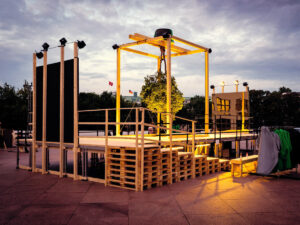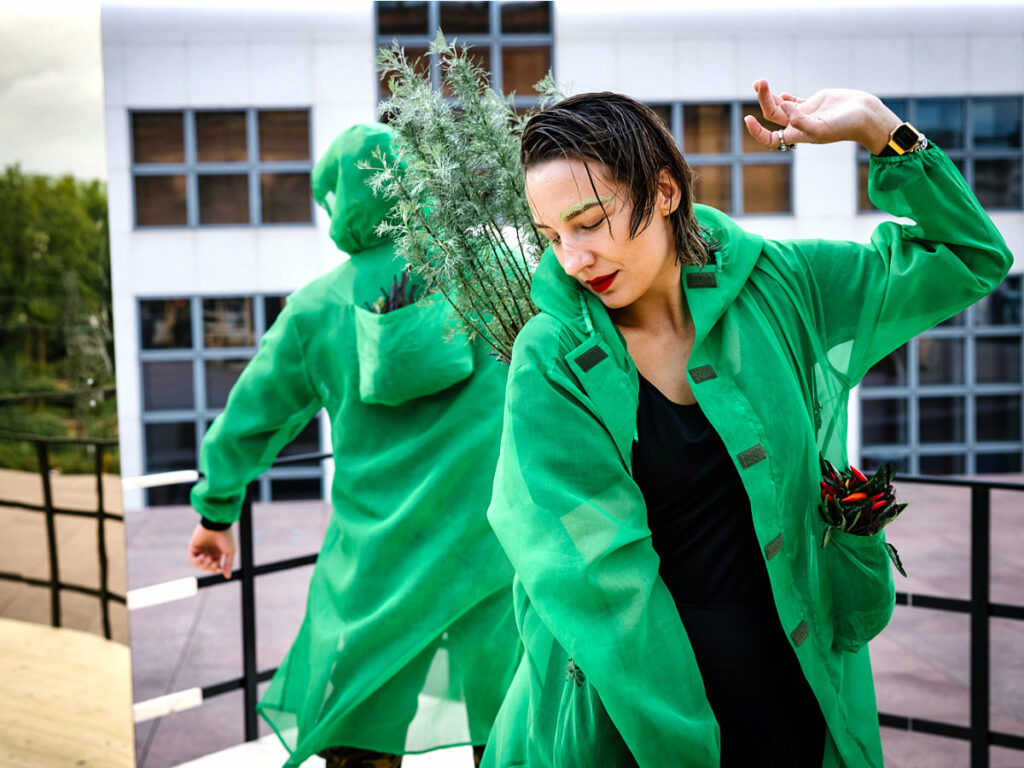10.September 2022 ::: 10-22 uhr
Kunstmeile Hamburg besetzt öffentlichen Raum mit Kunstaktion!
Am 10. September 2022 verwandelt sich unter der Regie des Künstlerkollektivs Baltic Raw Org der Glockengießerwall entlang der Ecke zur Ernst-Merck-Straße für einen Tag in einen ereignisreichen Erlebnisraum. An einem verkehrsreichen Knotenpunkt in Hamburgs City ist die Öffentlichkeit eingeladen, durch unterschiedliche künstlerische Interventionen den öffentlichen Raum anders zu erleben. Das partizipative Projekt „AprioRama“ bietet einen städtischen Gegenentwurf, in dem Natur und Kultur gemeinsam gedacht werden und der in viel fältigen Aktionen von den Besucher*innen aktiv mitgestaltet werden kann.
Die Kunstmeile Hamburg – die Gemeinschaft der fünf großen Kunstmuseen BUCERIUS KUNST FORUM, DEICHTORHALLEN HAMBURG, HAMBURGER KUNST HALLE, KUNSTVEREIN IN HAMBURG und MUSEUM FÜR KUNST UND GEWERBE HAMBURG – lädt das im Jahr 2000 gegründete Hamburger Kollektiv BRO zu einem künstlerischen Statement an einem verkehrsgeprägten Ort ein.
Immer wieder hat BRO in den vergangenen zwei Dekaden spektakuläre Interventionen vorgenommen, dadurch spezifische Orte des Stadtraums zurückerobert, brache Flächen mit situativer Aktionskunst besetzt und neue Impulse für eine aktive und ökologisch sensibilisierte Stadtgesellschaft gesetzt. Ihre Arbeit an der Schnittstelle von Bildender Kunst, Architektur und Stadtsoziologie wird sich auch in dieser Kunstaktion manifestieren.
„Mit der Kunstaktion setzt die Kunstmeile Hamburg als Gemein- schaft der fünf großen Kunstmuseen in Hamburg ein deut- liches Zeichen gegen die Klimakrise. Das Künstlerkollektiv Baltic Raw Org erobert den Stadtraum für die Menschen zurück und ebnet einen neuen Weg für das Hamburg der Zukunft.“
PROF. DR. ANDREAS HOFFMANN GESCHÄFTSFÜHRER BUCERIUS KUNST FORUM / GESCHÄFTSFÜHRER KUNSTMEILE HAMBURG
„Innenstädte müssen wieder Orte des gesellschaftlichen Austausches werden. Mehrspurige Straßenschneisen machen die Hamburger Innenstadt unattraktiv und lebensfeindlich.
Die künstlerische Intervention durch die Kunstmeile Hamburg zeigt, wie die Hamburger Innenstadt wieder ein kreativer Ort der Begegnung jenseits von Konsum und Verkehr werden kann.“
PROF. DR. ALEXANDER KLAR DIREKTOR HAMBURGER KUNSTHALLE
Text: ARTPRESS/Ute Weingarten
KUNSTMEILE HAMBURG
@deichtorhallenhamburg
@buceriuskunstforum
@hamburger.kunsthalle
@kunstvereinhh
@mkghamburg
⠀⠀⠀⠀⠀⠀⠀⠀⠀
ARTISTS*
Berndt Jasper & Móka Farkas (Baltic Raw Org)
Paul Speckmann (Sounddesigner/Musician)
Jil Lahr (“Trafik”-Installation/DJ)
Gwendolin Taube (“echt jetzt”-Installation)
Lars Vaupel (“echt jetzt”-Installation)
Ole Wulfers (uncomfortzone)
Gloria Brillowska (Costume Designer)
Aron The Cook & Offline (DJ’s) @aronthecook / @offline.atq
⠀⠀⠀⠀⠀⠀⠀⠀⠀
PERFORMER*
Nils Kleffner @nilsipilsii
Damaris Dominguez @_damarisdominguez
Brianna Drain @briastories
Simon Schultz @gitteschmitz
Mona Farivar @monafrvr
Yousef Iskandar @yousefiskandar
Sarah Plochl @saratoninne
Cesco Philip @cesco.blz
& the AUDIENCE
* Foto Max Hartmann / auch Titelbild
** Foto Maxe Probst






Climate engineering comprises intentional human interventions in the climate system. Manipulations of the entire system from currents of winds and the sea to solar radiation and the circulation of water. Efforts to neutralise the rapid processes of the last 200 years.
The consequences of the interventions are high-risk. It is difficult to calculate what cascades the interventions will entail, especially with a level of knowledge that cannot even reliably predict the weather three days ahead.
.
Two approaches are currently being researched to reduce atmospheric fever. On the one hand, efforts are being made to reduce solar radiation by having it absorbed or reflected by artificially constructed surfaces. A second field is dedicated to detoxifying the atmosphere by recycling greenhouse gases.
We have tried to translate the technologies into wearable fashion. The thesis is: if all 8 billion people wear these functional clothes, we can collectively reduce global warming by 0.5 C°.



If it gets too hot due to our fossil fumes, we can use surface treatments that create the so-called albedo effect to reduce the heating power of the sun.
The albedo effect is triggered when bright surfaces – such as snow and ice or white houses – reflect light back. Should silvery sparkling zones disappear, experiments are already being carried out with tiny glass spheres in the so-called Arctic Fram Strait between Spitsbergen and Greenland. These reflect sunlight and thus slow down the melting process. The application of glass spheres is also excellent instead of glaciers. Unfortunately, they are not degradable and remain in the landscape forever.
In addition, reflective particles of silver iodide can be sprayed like confetti in the – 14 km high – stratosphere. Unfortunately, they are not degradable either.
To make one’s own contribution to these efforts, it would be advisable to wear a silver top with matching headgear as one unit to offer the sun – seen from a bird’s eye view – a gapless façade as a defence.
.
.

Plants feed on carbon dioxide and store it in their tissue. Therefore, cultivating especially fast-growing plant species is considered a way to recapture at least some of the greenhouse gases and thus buffer climate change.
You can explore the world emission-free on foot or by bike with this beautifully designed plant apron.
.
.

You can wear the rain gear on cooler windy days even in bright sunshine to do good. Defending against the eternal radiation can also be done by absorption and hiding, as moorland landscapes – which swallow light like heat – show. Deep blackness also cools the planet in this wayThe climate technology function of the basalt jacket is to bind carbon dioxide by rainy Weather.
Carbon dioxide in rain becomes sparkling water. When fizzy water meets basalt rock, it reacts to form bicarbonate and remains bound. In this way, carbon dioxide is extracted and stored.
According to current plans, large areas of coasts and beaches are to be filled with basalt flour so that the powder can finally bind the CO2 absorbed by the oceans.
Social sculpture












BYE *




























































